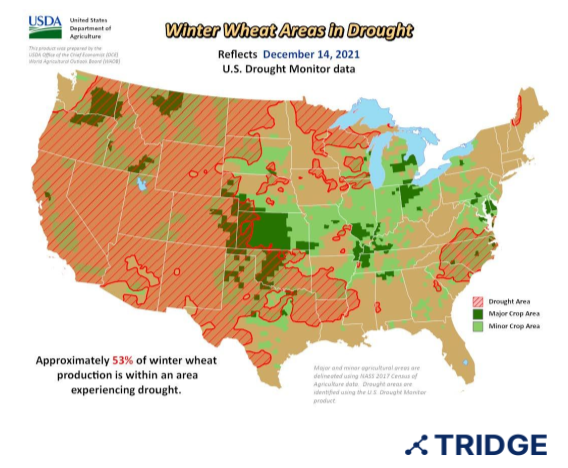U.S's Wheat Production and Exports Down Again Due to Droughts

Wheat is the third largest planted field crop in the U.S. right behind corn and soybeans. The area under wheat was recorded as 37.2 million acres in 2021, slightly more than the 2020 area. However, a general trend of steady decline in the planted and harvested wheat area was seen in the U.S. over the past decade. USDA projects that wheat acres by MY 2030/31 will decrease to around 44.5 million acres, which would be below the recent five-year average of 46.7 million.
Furthermore, this MY was a nightmare for the wheat farmers across the U.S. and Canada due to persistent droughts which reduced the harvest and quality of wheat produced. As we move towards the winter wheat crop, 53% of the crop is falling in the area facing extreme drought conditions. Before the winter season, drought conditions expanded to other Northern and Western regions as well, which potentially affected the production of other classes of wheat in the country. Overall, the wheat production for this MY was less than average translating into a lower volume of exports from the country.

Source: USDA.
Traditionally the U.S. ranks as the second-largest wheat exporting country in the world. In 2020, the country exported 26.23 million tons of wheat with a share of 14.1% in the total value of exports. During the first 10 months of 2021, the volume of wheat exports was recorded at 21.20 million tons which are 5.5% less than the previous year. USDA/Foreign Agricultural Service’s Export Sales data show that there was a continuous decline in the pace of sales and shipments throughout November, suggesting that a quick turnaround in export pace is unlikely.

Source: ITC Trade Map. 1001 Wheat and meslin
The tight domestic supplies and high prices made U.S. wheat uncompetitive in the international trade market in comparison to other major exporters. The country continued to maintain its exports to core markets in Latin America this year but was not able to capture major markets in Asia and Africa. With global consumption expected to outpace production even in the coming years, the tight global supplies of the milling-quality wheat limit will remain downside price risk and leave the market sensitive to supply-side shocks for at least two more crop years.
Sources
- ERS, USDA. Wheat Outlook: December 2021.
- ITC TradeMap. HS Code: 1001 Wheat and meslin
- The Western Producer. “Dry conditions threaten the U.S. winter wheat crop.”